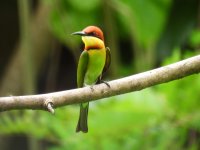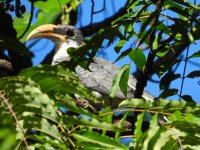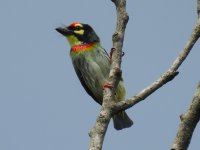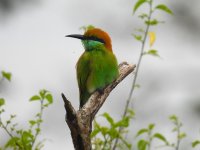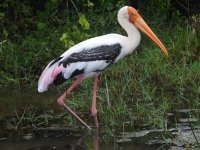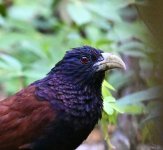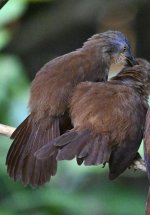sbradfield
Well-known member
A trip report from our recent trip to Sri Lanka. A longish read and I hope it is useful
Trip Report Sri Lanka November 2023
Participants:- Simon Bradfield, Simon Hitchen, Dave Rose, guided by Thilina Karunanayaka
The logistics/tripadvisor bits -you can skip this if you just want to read about the birds.
This was effectively a 9 night/10 day trip although the first day was taken up with flying (leaving UK c 1pm arriving 9am the next day in Sri Lanka) as was the last day (leaving Sri Lanka c10am arriving UK 6pm) with 8 full days of birding.
Flights
Although direct flights are available it was much cheaper to fly via a connection in Dubai. 2 of us flew from Gatwick and 1 from Manchester to meet in Dubai and then go on together to Colombo. We flew with Emirates. I would not recommend them. Both flights out of the UK were delayed and the Gatwick flight was so late we came within a whisker of missing the onward flight, having to sprint through the dreadful Dubai airport which seems to lack signage.
Worse was to come on the way back. Although the Gatwick flight was ok the Dubai to Manchester flight had a 12 hour delay! On board service and quality was poor too, compared to other airlines I’ve flown with recently.
Accommodation in Sri Lanka
We stayed in 5 different locations
Kitulgala Rest House, Kitulgala. A charming characterful property. Very comfortable rooms and the best choice of food. Good birding in the grounds and great views of the river.
Ivy Bungalow, Nuwara Eliya. Much more modern property, again very comfortable. Nowhere to walk in the grounds but balconies over looked small paddies and arable gardens which had some birds.
Hibiscus Garden Hotel, Tissamaharama. Super hotel, fantastic birding in gardens, great rooms in separate buildings (like an African safari lodge). The pool looked good too. It’s right on the edge of Bundala national park and close to Yala national park. This would be ideal for the birder on holiday with their family.
Rock View Motel, Sinharaja. Most basic of the 5 but still comfortable. Spectacular views over the valley and had an Oriental Magpie Robin roosting in its dining room each night.
Euro Star Hotel, Colombo. Airport hotel with large comfortable rooms and bonus roosting Indian Scops-Owls in the car park.
In all hotels the staff were really friendly and we felt very much at home. All had free WiFi although in most it was limited to reception area and not available in rooms. I’d happily stay in any of them again.
Itinerary and Guiding
We booked with Walk With Jith www.walkwithjith.com direct in Sri Lanka. Communications with Jith were great. He was very responsive to emails and very accommodating with tweaks we wanted to make to the itinerary. The Itinerary focussed on trying to see all 34 endemics of Sri Lanka with some additional time at Bundala for wetland species.
Our guide on the ground was Thilina Karunanayaka. Thili is a superb guide, he really knows the birds and knows how to find them and works hard to make sure you get to see them. He has plenty of local contacts for up to date information. He is also great company. We thoroughly recommend Jith and Thilina to anyone visiting Sri Lanka.
Trip Report Sri Lanka November 2023
Participants:- Simon Bradfield, Simon Hitchen, Dave Rose, guided by Thilina Karunanayaka
The logistics/tripadvisor bits -you can skip this if you just want to read about the birds.
This was effectively a 9 night/10 day trip although the first day was taken up with flying (leaving UK c 1pm arriving 9am the next day in Sri Lanka) as was the last day (leaving Sri Lanka c10am arriving UK 6pm) with 8 full days of birding.
Flights
Although direct flights are available it was much cheaper to fly via a connection in Dubai. 2 of us flew from Gatwick and 1 from Manchester to meet in Dubai and then go on together to Colombo. We flew with Emirates. I would not recommend them. Both flights out of the UK were delayed and the Gatwick flight was so late we came within a whisker of missing the onward flight, having to sprint through the dreadful Dubai airport which seems to lack signage.
Worse was to come on the way back. Although the Gatwick flight was ok the Dubai to Manchester flight had a 12 hour delay! On board service and quality was poor too, compared to other airlines I’ve flown with recently.
Accommodation in Sri Lanka
We stayed in 5 different locations
Kitulgala Rest House, Kitulgala. A charming characterful property. Very comfortable rooms and the best choice of food. Good birding in the grounds and great views of the river.
Ivy Bungalow, Nuwara Eliya. Much more modern property, again very comfortable. Nowhere to walk in the grounds but balconies over looked small paddies and arable gardens which had some birds.
Hibiscus Garden Hotel, Tissamaharama. Super hotel, fantastic birding in gardens, great rooms in separate buildings (like an African safari lodge). The pool looked good too. It’s right on the edge of Bundala national park and close to Yala national park. This would be ideal for the birder on holiday with their family.
Rock View Motel, Sinharaja. Most basic of the 5 but still comfortable. Spectacular views over the valley and had an Oriental Magpie Robin roosting in its dining room each night.
Euro Star Hotel, Colombo. Airport hotel with large comfortable rooms and bonus roosting Indian Scops-Owls in the car park.
In all hotels the staff were really friendly and we felt very much at home. All had free WiFi although in most it was limited to reception area and not available in rooms. I’d happily stay in any of them again.
Itinerary and Guiding
We booked with Walk With Jith www.walkwithjith.com direct in Sri Lanka. Communications with Jith were great. He was very responsive to emails and very accommodating with tweaks we wanted to make to the itinerary. The Itinerary focussed on trying to see all 34 endemics of Sri Lanka with some additional time at Bundala for wetland species.
Our guide on the ground was Thilina Karunanayaka. Thili is a superb guide, he really knows the birds and knows how to find them and works hard to make sure you get to see them. He has plenty of local contacts for up to date information. He is also great company. We thoroughly recommend Jith and Thilina to anyone visiting Sri Lanka.












